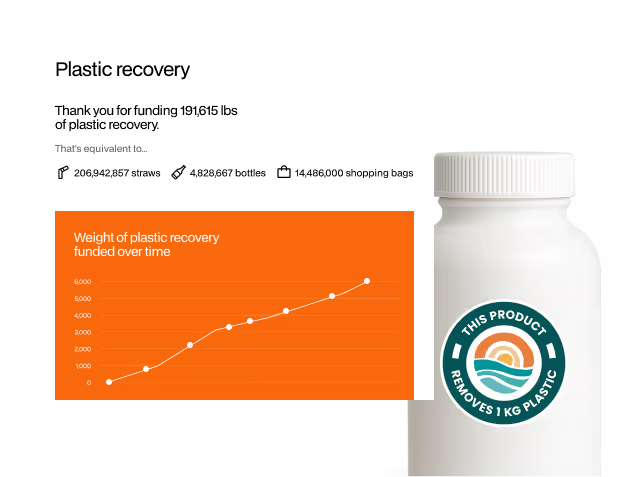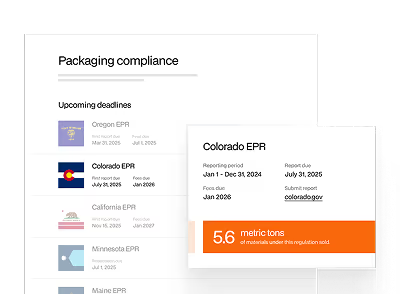EPR Overview
Who: CPG brands selling over $1 million annually in California with covered packaging materials (plastic, paper, glass, metal, and compostable materials).
What: You must register your company here and submit detailed packaging data for all products sold in California. This includes weight, format, materials, and sales volume data that will serve as your baseline for future compliance.
When: Register with CAA by September 5, 2025. Submit 2023 packaging data by November 15, 2025.
Where: California (following Oregon and Colorado, with more states to follow in 2026).
Why: Think of it as "you packaged it, you manage it." Companies report packaging data and eventually pay fees to support waste management infrastructure.
New to EPR? Read our complete guide: Understanding Extended Producer Responsibility (EPR): What CPG Companies Need to Know or Take the 5-Minute EPR Risk Assessment to see if your company is liable.
California Rulemaking Updates
If you're feeling overwhelmed trying to keep track of updates from California's EPR program, you're not alone. While CalRecycle continues revising regulations, the core message remains unchanged: your compliance obligations are non-negotiable.
November 15th Compliance Deadline
Despite ongoing regulatory revisions, the Plastic Pollution Prevention and Packaging Producer Responsibility Act (SB 54) remains legally binding. The statute itself—not the regulations being revised—establishes these critical deadlines. The Circular Action Alliance (CAA), approved as California's first Producer Responsibility Organization, is moving forward with data collection because the law requires it. Regulatory uncertainty doesn't pause statutory requirements.
Think "Data Year," Not "Fee Year"
Here's some relief for your budget planning: reporting does not equal paying fees yet. Think of 2025 as your "data year." While you must report by November 15, fees won't begin until 2027 at the earliest—after the PRO submits their Program Plan and CalRecycle approves it.
This timeline separation gives you a crucial advantage: establish your compliance processes now while the financial pressure is lower, positioning yourself ahead of competitors who are waiting for final fee structures.
California's Broader Scope: Don't Miss B2B Packaging
Unlike Colorado's EPR program, California includes B2B packaging that doesn't end up in residential waste streams. This broader scope means you need to capture packaging data that other state programs might exclude.
5 Steps to Take NOW for California EPR
1. Register by September 5
Use the CAA registration portal to register your company before the deadline. Don't wait for the reporting portal to open.
2. Identify All Covered Materials
Make sure you're capturing all packaging that falls under California's scope:
- All SKUs sold or distributed into California using covered materials
- Both consumer and B2B packaging (broader than other states)
- Plastic, paper, glass, metal, and compostable materials
3. Gather Your 2023 Baseline Data
Collect the following information for the period January 1 - December 31, 2023:
- Weight and format data for all packaging
- Brand ownership and licensing relationships
- California-specific sales volumes or estimates
4. Prepare for Portal Opening September 15
CAA's reporting portal opens September 15 and should contain detailed guidance. Have your data organized and ready to input when the portal becomes available.
5. Submit Everything by November 15
Complete your data submission by the November 15 deadline to establish your compliance foundation and avoid potential market access restrictions.
Timeline & Key Dates

Why You Should Get Started Now
Companies that organize their data now won't have to scramble when other states roll out requirements in 2026. You'll already understand your packaging footprint, have established data collection processes, and be positioned to handle whatever fee structures emerge in 2027.
More importantly, you'll avoid the potential consequences of non-compliance: market access restrictions in the nation's largest state economy and administrative actions once rules are finalized.
Navigate Complexity with Expert Support
Facing California's November 15 deadline doesn't have to be overwhelming. The rePurpose platform transforms the complexity of multi-state packaging compliance into a streamlined process that saves you time, money, and stress.
Save Time & Money: Instead of juggling spreadsheets across different state requirements, you upload your packaging data once and our platform handles the rest. Our algorithms automatically optimize your reporting to minimize fees while ensuring accuracy across all 90+ regulations we cover.
Simplify Reporting: When errors or missing data threaten your compliance, our built-in detection catches issues before they become costly problems. Our guided onboarding and automated report generation handle the formatting and submission requirements for each state's unique needs.
Access Expert Regulatory Intelligence: The real value comes from having regulatory intelligence built directly into your workflow. As requirements change across states, our platform updates automatically, flagging new compliance issues and surfacing requirements you need to know. From data validation to final report submission, our white glove approach means you focus on your business while we handle the regulatory complexity.
The impact for companies like yours:
- $50,000-$120,000/year saved in consultant fees or avoided headcount
- Up to $25,000/day in potential fines avoided through compliance
- 100% of customers reduce their packaging compliance costs
- One platform covers 90+ regulations including all EPR states
Ready to get compliant? Contact our team to learn how the rePurpose platform can simplify and streamline regulatory complexity.
For more regulatory intelligence and compliance guidance, explore our regulatory resource library


.png)
.avif)

.jpg)






